- Conclusion
- Part Four
- Part Three
- Part Two
- Part One
- Introduction
- Foreword

Dried marigolds used to make green dye
An alternative art school set in a quiet neighborhood, the

The Waldorf school sign outside of the main office
Waldorf school enriches its students with many types of knowledge that can help them become a more rounded and complete human being. The education is not cumbersome for the students, but is instead an enlightening experience. Students learn to cook, knit, and produce works of art in addition to standard school subject areas. How does a school based on old skills remain relevant in Silicon Valley? Gabrielle Westergren says “I think it is a great antidote to what a lot of our kids face in our popular mainstream culture” (Westergren). She feels that the methods used by the school help to create a harmony in the children, giving them real-world skills and the power to create instead of feeding them more technology.
“We now have a high school, we’re graduating our first senior class this year. It’s really exciting. Our seniors are getting into the colleges of their choice, so they’re really happy for that” (Wurtz). Equipped with the skills of both an art school and a standard school, the Waldorf graduates will have a full, rounded knowledge base to give them an edge in the professional world. Past Waldorf alumni from several locations are spread around the world, have attended all types of colleges, and work in a multitude of professions to improve the world.
Bibliography
Laurent, Monica. Personal interview. 11 Mar. 2011.
Lawrence, Robert. "Rudolf Steiner (1861-1925)." Skylark Books. Skylark Books, 2005. Web. 14 Mar. 2011. <http://www.skylarkbooks.co.uk/Rudolf_Steiner_Biography.htm>.
Leaming, Jeremy. "Charter for controversy: often touted as a breakthrough in 'educational choice,' charter schools instead are raising church-state problems around the country." Church & State 56.6 (2003): 9+. Student Resource Center - Gold. Web. 14 Mar. 2011.
Oppenheimer, Todd. "Schooling the imagination: Waldorf schools, which began in the esoteric mind of the Austrian philosopher Rudolf Steiner, have forged a unique blend of progressive and traditional teaching methods ..." The Atlantic Sept. 1999: 71-6,78+. Student Resource Center - Gold. Web. 14 Mar. 2011.
Pater, John. "An Introduction to Anthroposophy." Anthroposophy in Australia. N.p., n.d. Web. 14 Mar. 2011. <http://anthroposophy.org.au/index.php?view=article&catid=35:articles&id=47:an-introduction-to-anthroposophy&option=com_content&I temid=60>
Prescott, Jennifer O. "A day in the life of the Rudolph Steiner School." Instructor [1990] 109.4 (1999): 21+. Student Resource Center - Gold. Web. 14 Mar. 2011.
Westergren, Gabrielle. Personal interview. 10 Mar. 2011.
Wurtz, Lucy Valentine. Personal interview. 16 Feb. 2011.
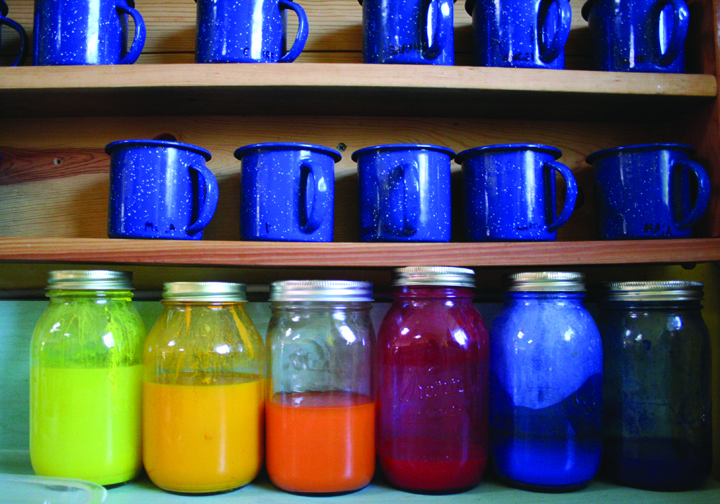
Paint jars and cups in third grade classroom
In such a creative environment, would the students be able to behave? According to
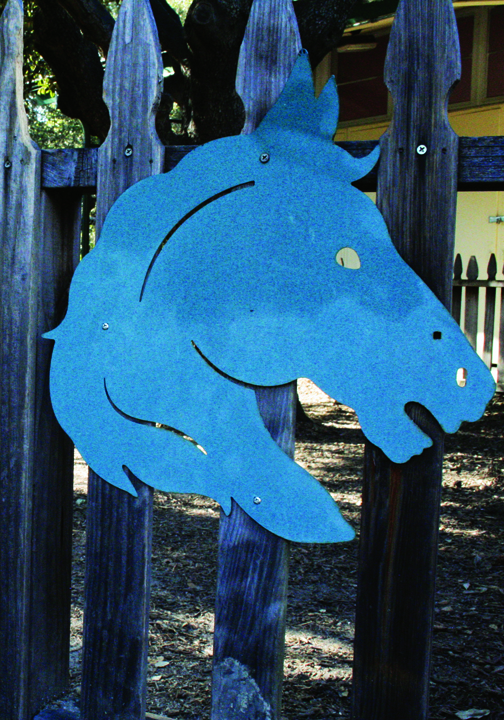
Metal horse head on fence
Lucy Wurtz and Monica Laurent, the students rarely misbehave. Wurtz explained that since the students are very close with the teacher, they want to behave well (Wurtz). If that is not a powerful enough deterrent from misbehavior, the students know that the same teacher will be with them for several more years, and it may be remembered. Laurent told me that sometimes the children coming in to the first grade from kindergarten have problems staying seated (Laurent). The kindergarten program is all about imaginative play and movement, so suddenly being asked to sit down and listen can be hard for the children to handle. These kinks are quickly smoothed out for most students.
Waldorf creates a very healthy environment for the children, and truly helps to “develop their lust for learning” (Wurtz). The children want to learn, and are so engaged by the classes that they love coming to school. “Really, without exception, even the middle schoolers love to be at school,” Lucy Wurtz told me with a proud smile.
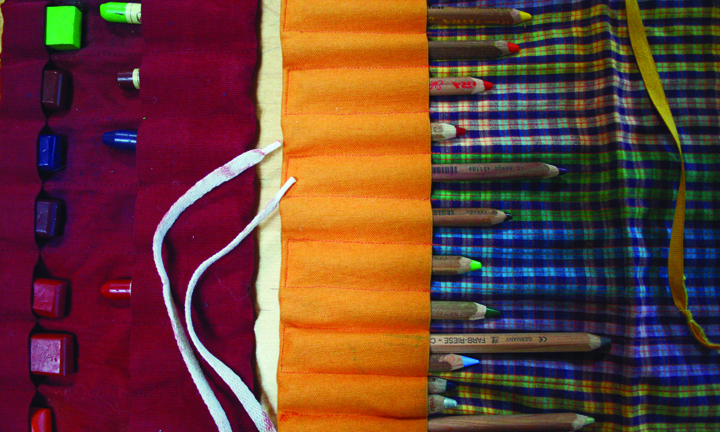
Writing utensils from a third grader's desk
Each Waldorf classroom has a color associated with it. The kindergarten has very light pink walls, the first grade has red walls, the second grade has orange walls, and so on. The colors correspond to the development of the child and to help even out some possibly negative tendencies of age brackets. For example, Ms. Laurent’s third grade room is a bright yellow. She says that it is bright because there is a tendency of children at that age to withdraw and become shy, but the yellow helps to bring energy and interaction to the group (Laurent). The opposite can be said for the fifth and sixth grade rooms, which are shades of blue. Some children in those grades become rowdy, so the blue brings a calming aura to the room.
Inside the desks are the childrens’ learning materials and lesson books, not textbooks. Lesson books are produced by the students during each month-long learning block, and serve as their own personalized textbooks (Prescott). They include illustrations, stories, diagrams, and decorations such as symmetric borders. When I visited Gabrielle Westergren, a devoted Waldorf parent, she brought out several lesson books by her children and enthusiastically showed me some of her favorites, including one from an Astronomy lesson block. The pages

Sewn tiger from animals in motion project
were dark blue, and the writing was done mainly in metallic colors. There were pages dedicated to the movement of the stars and the placement of constellations in each hemisphere. The lesson books qualify as both textbooks and works of art.
“We have a rhythm to our day,” Wurtz informed me. The first two hours of the day are spent in the main block with the primary teacher. Wurtz describes the main block as a “two hour window in the morning where they study one topic at a time, and through that topic, the language arts, math, science, and everything, is integrated.” A main block topic lasts for three or four weeks, and is focused

Colored wax in a basket
on one of a wide array of subjects, from botany to cooking to astronomy. Ms. Laurent’s third grade class is currently going through the clothing block. They are learning about different types of fiber and how clothing is made. After the daily main block, the group goes to the subject teachers. The main subjects include Spanish, handwork, gardening, eurhythmy, and games. In handwork, the children learn how to knit, crochet, sew, and embroider. Handwork is many of the students’ favorite class. Lucy Wurtz laughed softly as she said “my seventh grade son is sitting [in the car] knitting while he’s waiting for his brother to take him home... He’s making a scarf.” The students take care of the school’s garden and learn how to tend to plants in gardening. Eurhythmy is an element of Anthroposophy, and is a type of rhythmic movement used to express oneself. It is similar to sign language, but uses the whole body instead of just the hands. While Waldorf does not have a physical education class, it has a games class, another favorite among the students. The games played are generally nontraditional and not competitive, but very fun (Wurtz).
The Waldorf system spread to the United States eighty years ago, and has made its way to the West coast. The Waldorf School of the Peninsula is based in Los Altos, and it is the nearest Waldorf location; The next is in San Francisco.

Shoe rack outside of a classroom
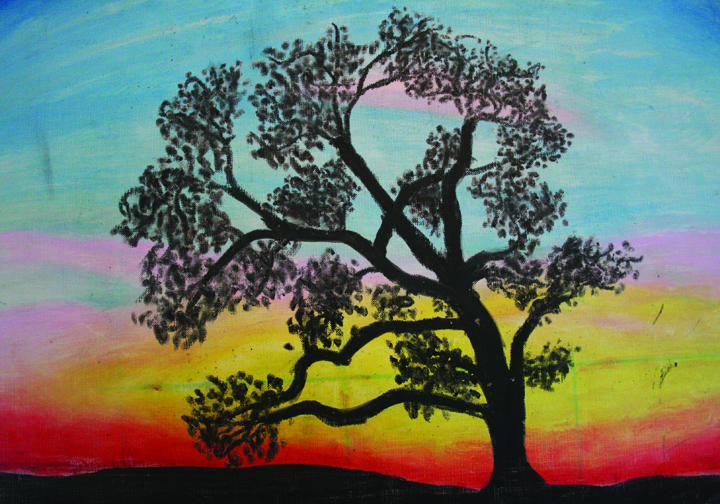
Painting of a tree made by a student
When a child is enrolled in a Waldorf school, the family has to adjust for them. One of the major changes that occurs is the cessation of television watching and other forms of media exposure. Yes, the children in the lower grades at Waldorf as well as their families are not supposed to watch their own television. The Waldorf school and teachers recommend very little to no media exposure until the age of 12. Some families oppose this, and decide to keep their children out of the Waldorf program. Other families, ones with children enrolled, continue watching television. However, the majority follow the set rules. Why? “We don’t recommend any media exposure when the children are really young, for developmental reasons, and because [we teach] by images a lot, we don’t want these other outside electronic images to come in the middle,” third grade teacher Monica Laurent explained to me (Laurent). Before I talked with Ms. Laurent, I believed this policy of Waldorf’s to be overpowering and invasive. However, after conducting research and interviews, the limited media exposure makes sense. Some of Waldorf’s major goals are letting the children keep the innocence and wonder of being young, as well as develop powerful self-confidence. The media can negate the efforts of the school in both of these aspects. Often when children are exposed to commercials and other media productions, they become materialistic and have lowered self-confidence. In essence, the restriction helps to keep the child’s health and well-being strong.

Some school supplies in shelves in the third grade classroom
In the Waldorf school, there are no grades, nor is there standardized testing. In place of grades, the teachers write out detailed progress reports for each student every month. The school believes that grades create unnecessary stress and do not allow children to reach their full potential. Lucy Wurtz, an administrator at the Waldorf School of the Peninsula, said “I have a kid in high school who says that he wishes they would just give grades, so he could stop and get an A, but they make him do essays, like, seven times, so for a student who is a good writer, you end up with a very polished essay” (Wurtz).
An element of the Waldorf school method that can be highly enriching is the bond between the teacher and the students. From the first grade through the eighth grade, a group of students will remain with a single teacher. In the majority of schools, students transfer to a different instructor each year, but the Waldorf schools hold the belief that nine months is not enough time for a teacher to get to know the children. The eight years spent with the group allow the teacher to truly learn how they work and behave. This permits the teacher to “tailor the curriculum to what that group of kids needs” (Wurtz).
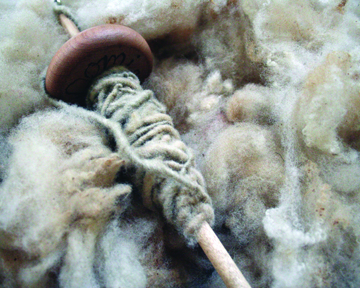
Spindle with natural sheep wool
The curriculum at Waldorf schools is split into three major parts based on the Anthroposophical concepts of spiritual and physical development. As Lucy Wurtz told me, “the younger years, from one to seven, really focus on developing the physical body and the will forces. [Then] the period from seven to fourteen is when the feeling life is really awakened,
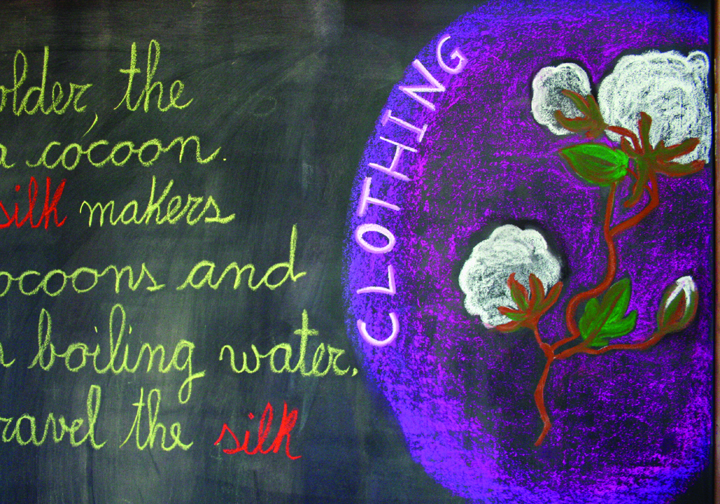
The main chalkboard during the clothing main block
and then when you’re fourteen up until adulthood, you’re really developing the thinking capacities. So, the curriculum mirrors that.” The learning comes to the child when they are ready for it.
Many parents are repelled from the school by the relaxed way that Waldorf schools teach, but mostly the parents are concerned with how Waldorf schools teach reading. At Waldorf, they do not force learning into the children (Wurtz). While the majority of schools teach their students how to read in kindergarten or the first grade, Waldorf lets reading come naturally to the child. Often, students are not fully reading until the third grade, which concerns a high number of parents. However, the majority of parents who end up enrolling their children at Waldorf support the late reading. As Monica Laurent put it, “In a society where things are going very fast, it might be a little scary, especially with the first or only child, to trust that things will come” (Laurent). Once the children are reading, however, they read at a level appropriate for their age. Monica Laurent continued, “Of course a five, four year old can learn how to read. You can sit them there and teach them how to read, but they can do that and miss out on playing and all sorts of stuff that is still learning. Once they get a little older they will not do much [playing] anymore because they’re past the age to do it” (Laurent).
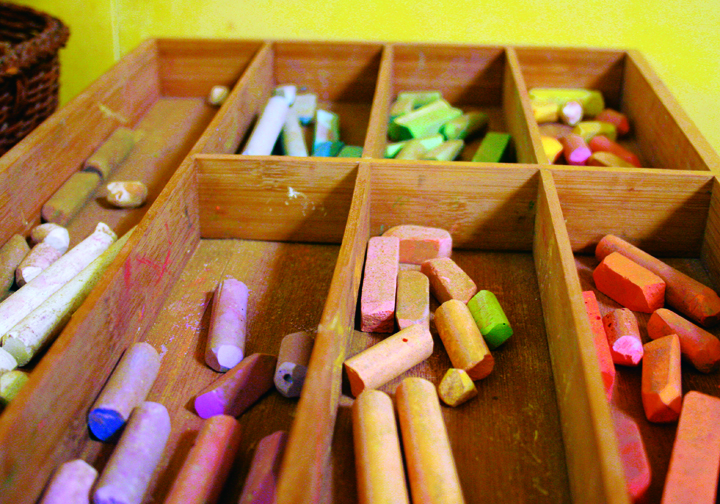
Chalk for the blackboard
Rudolph Steiner was born in February 1861 in a Hungarian village. During his youth, his family was forced to move multiple times, and Steiner became interested in a plethora of philosophical ideas. He “felt duty-bound to seek for the truth through philosophy” (Lawrence). At fifteen years of age, Steiner began tutoring students from his grade as well as lower grades. His early experience with education “sowed the seeds for the later development of a system of therapeutic education” (Lawrence). After years of study, Steiner formulated his own spiritual belief: Anthroposophy.

The Waldorf school sign outside of the main office
The Waldorf education movement began when Steiner gave a speech at the Waldorf-Astoria cigarette factory in 1919. Only a few months after the
first World War ended, “Steiner talked about the need for a new social order, a new sense of ethics, and a less damaging way of resolving conflict” (Oppenheimer). The owner of Waldorf-Astoria factory expressed a desire for Steiner to open a school for the workers’ children. The school that was organized was named Waldorf because its purpose was to educate the children of the Waldorf factory. Shortly after the original Waldorf school was opened, many more popped up across Europe. The movement rapidly spread, and around eighty years ago, the first Waldorf school opened in New York City (Prescott).
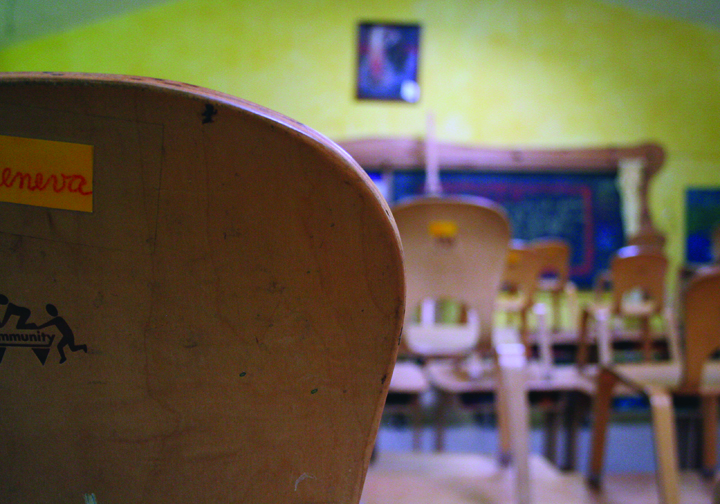
View of the classroom from behind a student's chair
What is Anthroposophy? According to John Pater, “there is no brief or easy answer as to what Anthroposophy is.” I will not go too deeply into the topic, but instead give a short overview. Unlike Theosophy, Anthroposophy is derived from human knowledge. It is a relatively generic belief relating the physical world with the spiritual world. Anthroposophy is an idea that can be applied to nearly any religion or belief system. It encourages acceptance of every belief, no matter how different it may be from your own. At its core is human soul development through a rounded education; This is Anthroposophy’s best known practical application (Pater).
There has been some controversy regarding the use of Anthroposophy in the educational world. Jeremy Leaming from Church & State writes that some religious families have pulled their children out of the Waldorf school system because they fear that Anthroposophy “is a cult created by Steiner” (Leaming). Some may consider this an absurd accusation, but these parents strongly believe it. One group went so far as to file a lawsuit against the school, but it was quickly thrown out of court.
I was led into a room with a rainbow of yarn hanging from one wall and partly finished art projects leaning against the next. A large bowl filled with pine cones and other natural materials was set on a table to my right. There was a girl who appeared to be in the seventh grade seated at the center
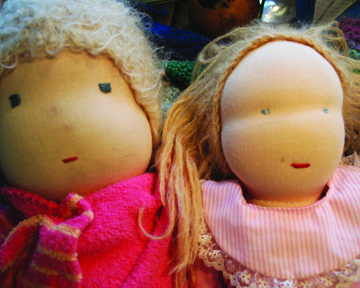
Dolls made by Waldorf students
table. She was intensely fixed on attaching layers of yarn to a doll’s head. The teacher inside the room greeted my guide and me, then proceeded to inform us that the room was “rather bare at the moment.” The two women showed me examples of craft projects that students create throughout their years at the school, ranging from embroidery to dolls to crocheted hats. At a typical elementary school, this type of arts and crafts room might be visited by each classroom once every week or two, if there is an arts room at all. Here, this room is used by every grade at least biweekly; Art is a core part of the curriculum.
My guide continued to show me many of the main classrooms. Each of the rooms had a monochromatic theme fitting the age group they are used by. She particularly enjoyed the third grade classroom and the bright yellow walls. “Isn’t it beautiful?” she sighed, admiring the aesthetic of the room. In another grade, she showed me an art display of rainbow watercolors. She explained to me that they took weeks to make because each layer of paint is very thin, and

A carved statuette
you can only see the color come out after several coats. The children at this school produce works of art that look very professional, especially when compared to art of similar children their age in a standard school.
What is this magical place? The Waldorf schools are alternative arts-based K-12 schools that are based on the teachings of Rudolph Steiner. The
learning method employed by Waldorf schools includes a developmentally based curriculum, and aims at teaching the whole human being through art. The Waldorf movement is growing, allowing more children to access the unconventional yet effective school system.
The Waldorf program is very popular: The schools’ waiting lists are long for every grade. This is an odd phenomenon. Consider the skills that are useful in our world. These may include computer knowledge and proper use of technologies, but not art. We practically make fun of artists, and barely consider it a profession. On my Waldorf tour, I noticed that there was not a single computer intended for student use. Since our world is so full of technology, how is a school based on practical arts and old methods supposed to survive? Can the Waldorf schools truly prepare their students for a high-tech world?
Seven years ago, when I still wore glasses and had hair extending to the base of my spine, my mother wanted me to make a big decision. She was allowing me to decide where I would go to school for the next year. I had not recently moved to the district; I was just changing schools, again.
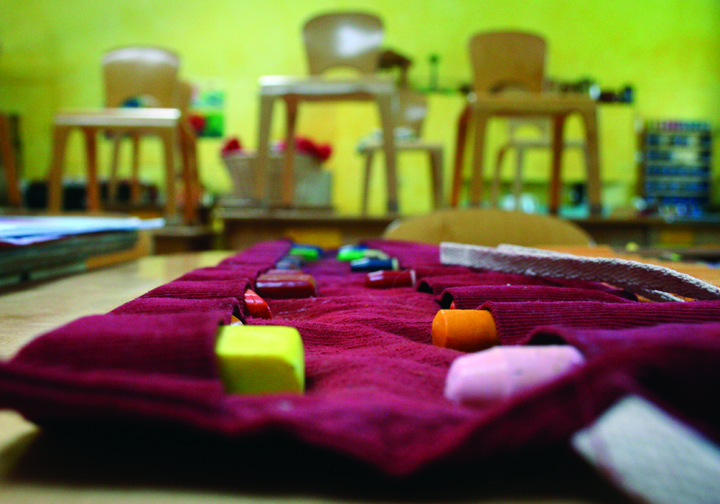
A close-up of natural wax crayons
When I started my elementary school years at the local public school, I was far ahead of my class. I already knew how to read while they were practically learning the alphabet. My teacher would not allow me to read in class because she was afraid it would damage my classmates’ self-esteem. With justification, my mother was angered and decided to move me into a private school. After two years there, I was far too stressed for a third grader. My mother decided to try out homeschooling, but, in truth, it ended up being a year off of school. Realizing that homeschooling was not for me, she resolved to find a new school to enroll me in.

Chalkboard in the clothing block
The more interesting of the options given to me was an alternative school just two blocks down my street: The Waldorf School of the Peninsula. I discovered, however, that to attend Waldorf, I would need to be put back a grade due to their different age cutoffs. Not wanting to go through another year of the fourth grade, I chose the other school.
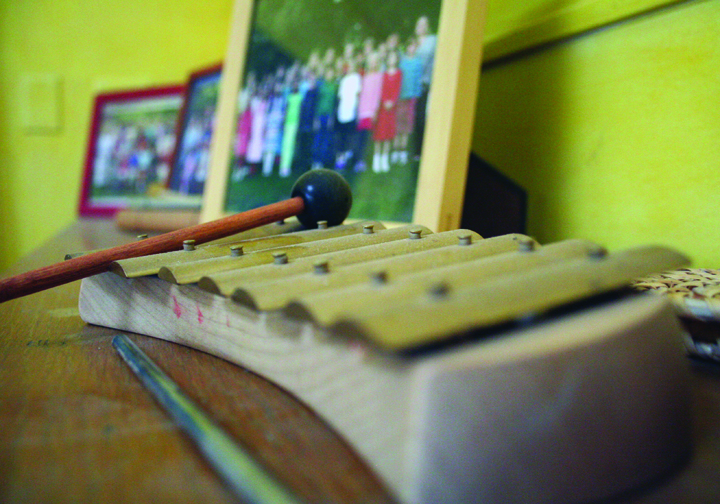
A xylophone on top of a piano in the third grade room
Years later, I had to pick a subject for this documentary project. I was lost in a sea of vague and not-so-brilliant ideas. Desperate, I turned to my mother. She suggested that I research the Waldorf schools. At first, I scoffed at her idea simply because she was my mother. A few days later, I started reading about the schools and actually became interested.
Just two blocks away from me, there was a school where children learned how to knit in the first grade. I tried learning how to knit in the ninth grade, and failed miserably. It intrigued me that children far younger than myself were learning complex skills that were difficult for a freshman in
high school. Cooking, crocheting, cross-stitching, and creativity were all parts of the Waldorf curriculum.
After research, work, and several visits to the school, I realized something. I wished I had chosen the Waldorf school.